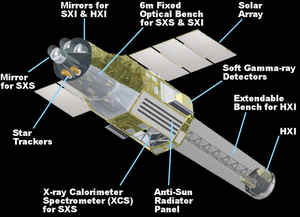 Artist depiction of Hitomi satellite | |||||||||||
| Names | ASTRO-H New X-ray Telescope (NeXT) | ||||||||||
|---|---|---|---|---|---|---|---|---|---|---|---|
| Mission type | X-ray astronomy | ||||||||||
| Operator | JAXA | ||||||||||
| COSPAR ID | 2016-012A | ||||||||||
| SATCAT no. | 41337 | ||||||||||
| Mission duration | 3 years (planned) ≈37 days and 16 hours (achieved) | ||||||||||
| Spacecraft properties | |||||||||||
| Launch mass | 2,700 kg (6,000 lb) [1] | ||||||||||
| Dimensions | Length: 14 m (46 ft) | ||||||||||
| Power | 3500 watts | ||||||||||
| Start of mission | |||||||||||
| Launch date | 17 February 2016, 08:45 UTC[2] | ||||||||||
| Rocket | H-IIA 202, No. 30 | ||||||||||
| Launch site | Tanegashima Space Center | ||||||||||
| End of mission | |||||||||||
| Disposal | Destroyed on orbit | ||||||||||
| Destroyed | 26 March 2016, ≈01:42 UTC [3] | ||||||||||
| Orbital parameters | |||||||||||
| Reference system | Geocentric orbit[4] | ||||||||||
| Regime | Low Earth orbit | ||||||||||
| Perigee altitude | 559.85 km (347.87 mi) | ||||||||||
| Apogee altitude | 581.10 km (361.08 mi) | ||||||||||
| Inclination | 31.01° | ||||||||||
| Period | 96.0 minutes | ||||||||||
| |||||||||||
X-ray astronomy satellite in Japan | |||||||||||
Hitomi (Japanese: ひとみ), also known as ASTRO-H and New X-ray Telescope (NeXT), was an X-ray astronomy satellite commissioned by the Japan Aerospace Exploration Agency (JAXA) for studying extremely energetic processes in the Universe. The space observatory was designed to extend the research conducted by the Advanced Satellite for Cosmology and Astrophysics (ASCA) by investigating the hard X-ray band above 10 keV. The satellite was originally called New X-ray Telescope;[5] at the time of launch it was called ASTRO-H.[6] After it was placed in orbit and its solar panels deployed, it was renamed Hitomi.[7] The spacecraft was launched on 17 February 2016 and contact was lost on 26 March 2016, due to multiple incidents with the attitude control system leading to an uncontrolled spin rate and breakup of structurally weak elements.[8]
- ^ Cite error: The named reference
astroh-presskitwas invoked but never defined (see the help page). - ^ Cite error: The named reference
sfnow20160217was invoked but never defined (see the help page). - ^ Cite error: The named reference
spnews20160329was invoked but never defined (see the help page). - ^ Cite error: The named reference
heavens-abovewas invoked but never defined (see the help page). - ^ Cite error: The named reference
AstroH_NASAwas invoked but never defined (see the help page). - ^ Cite error: The named reference
Space_17Feb16was invoked but never defined (see the help page). - ^ Cite error: The named reference
Cambridgewas invoked but never defined (see the help page). - ^ Clark, Stephen (18 April 2016). "Attitude control failures led to break-up of Japanese astronomy satellite". Spaceflight Now. Retrieved 21 April 2016.